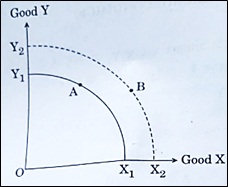Economics : 2019 : CBSE : [All India] : Set 2
To Access the full content, Please Purchase
-
Q1
The coefficient of price elasticity of supply of a good is 3. It is known as _________. (Choose the correct alternative)
(a) Unitary Elastic Supply
(b) Perfectly Inelastic Supply
(c) Elastic Supply
(d) Inelastic Supply
Marks:1View AnswerAnswer:
(c) Elastic Supply
Explanation:
When there is more percentage change in quantity supplied due to a percentage unit change in price, it is known as elastic supply.
-
Q2
Shift from point A on Production Possibility Curve X1Y1 to Point B on X2Y2 in the given figure indicates: (Choose the correct alternative)

(a) Decrease in resources
(b) Increase in resources
(c) Full and efficient utilitsation of resources
(d) Wastage of resources
Marks:1View AnswerAnswer:
(b) Increase in resources
Explanation:
In the given figure, PPC has shifted to right at all points, it implies that the production of both the goods has increased at given the level of technology.
-
Q3
A Production Possibility Curve (PPC) would be convex to the origin if Marginal Rate of Transformation (MRT) is ______. (Fill up the blank)
Marks:1View AnswerAnswer:
decreasing
Explanation:
Marginal Rate of Transformation = Δ Y/ Δ X is continuously decreasing. It implies that in order to produce more of one good X, we have to sacrifice more units of good Y.
-
Q4
The shape of the average revenue curve under perfect competition would be ________. (Fill up the blank)
Marks:1View AnswerAnswer:
parallel to X-axis
Explanation:
The shape of the average revenue curve under perfect competition is parallel to X-axis. It is because in perfect competition, commodities are sold at uniform prices and the price is equal to marginal revenue which is equal to average revenue.
-
Q5
Mention any two examples of implicit cost incurred by a firm.
Marks:1View AnswerAnswer:
The two examples of the implicit cost incurred by a firm are as follows:
- Use of own building for production purposes by factory owner, and not receiving rent.
- Use of own capital to purchase machinery for the production and not charging any interest
-
Q6
Define variable cost.
Marks:1View AnswerAnswer:
The expenditure made on the purchase of a variable factor of production or to hire casual labourer is termed as variable cost.
-
Q7
Discuss briefly the central problem of ‘‘For whom to produce’’.
Marks:3View AnswerAnswer:
For whom to produce is related to the problem of choice between different ways of the personal and functional distribution of income. It is concerned with the decision of how the share of different factors of production in the total national product of the country is to be decided.
The production or output in an economy is the result of the combined efforts of various factors of production. Hence, the output should be distributed among these factors of production. But the point related to the problem is how should it to be distributed or how the shares of different factors of production should be determined?
-
Q8
Classify the following statements into positive economics or normative economics, with suitable reasons :
(a) Government should try to control the rising fiscal deficit.
(b) Real Gross Domestic Product (GDP) is calculated on the basis of ‘base year price’.
Marks:3View AnswerAnswer:
(a) Normative Economics
Reason: Normative economic analysis describes “what ought to be”. Its objective is to determine the norms. Normative statements pronounce value judgment or an opinion relating to right or wrong of a particular policy matter and it is always a matter of debate.
(b) Positive Economics
Reason: Positive statements describes what was, what is and what would be under the given set of circumstance. All the statements are verified empirically.
In the given situation, the Real Gross Domestic Product is calculated on the basis of ‘base year price’ which can be verified with available data.
-
Q9
Discuss the relationship between total utility and marginal utility, using a hypothetical schedule.
Marks:3View AnswerAnswer:
Total utility is defined as the total psychological satisfaction derived from the given stock of the commodity consumed. It can be estimated as the sum total of marginal utilities derived from the commodity.
TU =∑MU
Marginal utility is defined as the utility derived from the additional unit of the commodity consumed. It can be estimated as the change in TU due to change in one unit of the commodity consumed.
MUn = TUn - TUn – 1
For example, if the consumption of first unit of the commodity gives the satisfaction of 20 utils and the consumption of the second unit of the commodity gives 15 utils of satisfaction, then the total utility derived from consumption of one commodity is 20 utils and from consumption of two commodities will be 35 utils and the marginal utility for the consumption of the second unit will 15 utils.
Unit MU TU 1 20 20 2 15 35 3 12 47 4 10 57 -
Q10
Discuss briefly the meaning of "Price discrimination" and "Product differentiation" with the help of suitable examples.
Marks:4View AnswerAnswer:
Price discrimination indicates a situation when a producer sells the same commodity to different buyers at two or more different prices. This is done to earn maximum profit. For example, the electricity board sells electricity at a cheaper rate for household use than for commercial use.
Product differentiation is a situation observed in an industry where each firm produces a product that is somewhat different from the products of its competitors, but the products of different firms are not entirely different. The products are close substitutes but not perfect substitutes. For example, in the aviation industry different airline service providers provide a method to travel but services of every provider are different from another.



